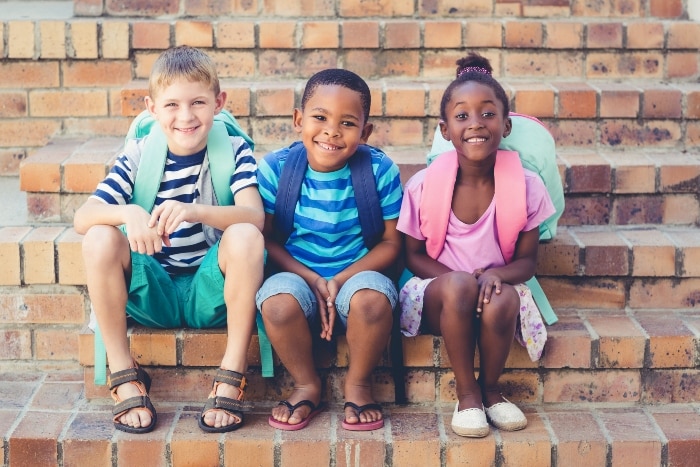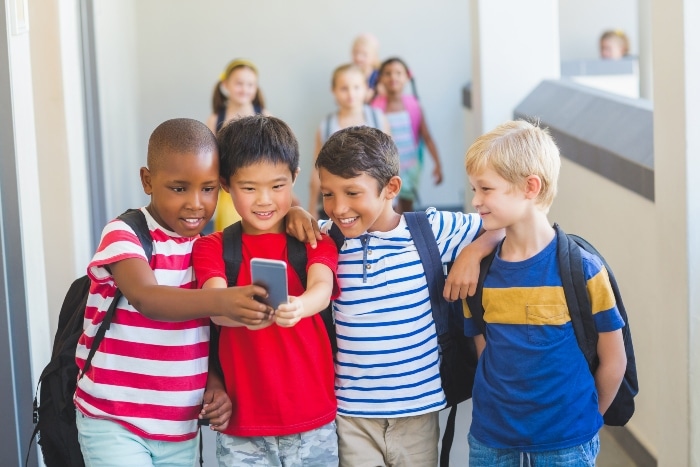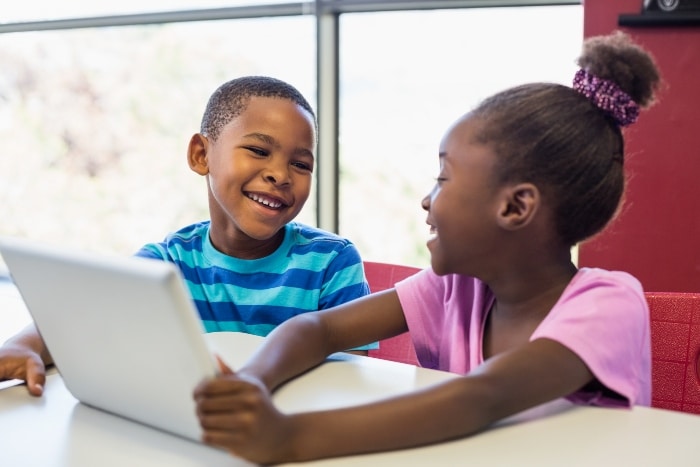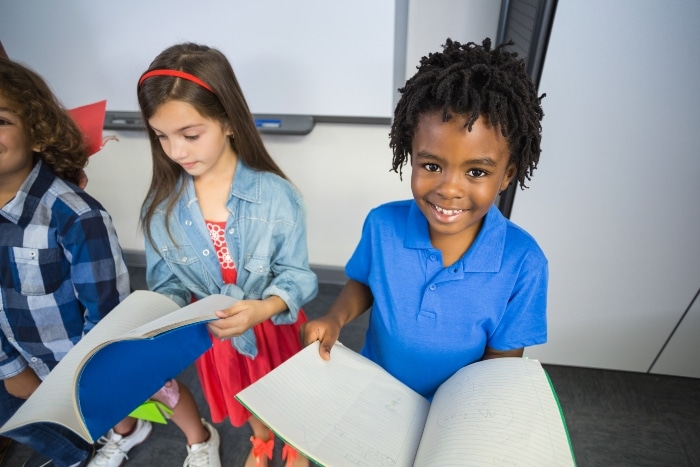As the kids are heading back to the classroom there are things that you can do to ensure that your child is safe. Your child’s safety this school year should be the top priority, learn how to protect your child with this back to school safety checklist.
Many parents post back to school pictures and sometimes include details that could potentially put your child in danger. Our local police department pointed out information not to share about your child in photos. Here are a few: bus number, house number, what school they go to, photo in front of their school with the name on it, and potentially other information that could cause a predator to prey on your child. So I wanted to give you a comprehensive “Back to School Safety Checklist” to help ensure that students are prepared and safe as they return to school:

Personal Safety
It is important for you to teach your children their contact information, stranger danger, follow safe routes to and from school, and always use the buddy system.
- Contact Information: Ensure your child knows their full name, address, and emergency contact numbers.
- Stranger Awareness: Teach children to avoid talking to strangers and to report any suspicious behavior.
- Safe Routes: Identify the safest route to and from school, including safe places to go in an emergency.
- Buddy System: Encourage walking to school or the bus stop with a friend or group.
Transportation Safety
What type of transportation modes do your kids use on a daily basis? You want your child to be familiar with their mjode of transportation whether they ride the bus, car rider, bike, or even walk home.
- Bus Safety:
- Teach children to stand back from the curb while waiting for the bus.
- Ensure they know to remain seated and keep aisles clear during the bus ride.
- Car Safety:
- Always use seat belts or appropriate car seats.
- Avoid distractions if driving your child to school, and obey all school zone speed limits.
- Bike Safety:
- Ensure the bike is in good working condition.
- Teach children to wear helmets and follow traffic signals and signs.
- Equip bikes with reflectors and lights if biking in low light.
- Walking Home:
- Teach your child to walk on the sidewalk on the opposite side of the street whenever possible. This is so your child can see oncoming traffic.
- Never get into a car with someone you don’t know.
- Walk with a buddy whenever possible.
- Tell your child to scream, make loud noises, or call 911 from their cell phone if someone is trying to lure them into a car, being bullied, or feel like they are in danger.
- Put a GPS tracking device (Aff link) in your child’s backpack. This will allow you to track your child without them needing a phone on them.
School Environment Safety
Your child’s school usually has these safety procedures and policies outlined in their student handbook. But if you don’t want to read the entire thing here are a few important topics to discuss with your child.
- Emergency Procedures: Review the school’s emergency protocols, including fire drills, lockdowns, and evacuation routes.
- Bullying Prevention: Discuss the importance of speaking up about bullying and knowing how to get help. They need to tell an adult whether it is a teacher, teacher’s aide, principal, counselor, or even their parent. Your child shouldn’t be scared to tell someone they trust. Telling someone can help stop the bullying.
- Allergy Awareness: Make sure the school is aware of any allergies your child has, and that appropriate measures are in place. See below under medication management.
- COVID-19 Precautions: Ensure that your child understands any current health protocols such as hand washing, wearing masks, or social distancing, if applicable.
Health and Wellness
Your child is never to young to learn how to take control over their own health and wellness. They will need to have those skills as an adult, so the more they can learn now, then your child will be prepared for the future.
- Vaccinations: Ensure your child is up-to-date on required vaccinations.
- Medication Management: If your child takes medication, confirm the school has the correct instructions and supply. Most schools require the nurse to keep the medication in the nurse’s office. In order for the nurse to administer any medication, your child will likely need a parent and doctor note with the name of the medication, dosage, and instructions.
- Healthy Habits: Encourage good hygiene, regular hand washing, and balanced nutrition.
- Sleep Schedule: Establish a consistent sleep routine to ensure your child is well-rested.
Digital Safety
Kids can be naive and not realize the dangers that lurk on the internet. But there are a few things that you can discuss and teach your child how to behave while using their devices.
- Internet Use: Set clear rules for internet and social media use, and discuss online safety and cyberbullying. Parents you can even add a router that filters traffic that you don’t want your child to see.
- Screen Time: Monitor and limit screen time to ensure it doesn’t interfere with homework or sleep.
- Device Security: Install security software on any devices your child uses and teach them not to share passwords. Also, don’t be afraid to set up parental controls too.

Emergency Preparedness
Emergencies happen and it is important for your child to know what to do in that situation. They should always find the closest adult and let them know what is going on. But you also, want to make sure that you keep up to date emergency contacts and have a back up person to contact if you or your emergency contact is unavailable.
- Emergency Contacts: Update emergency contact information with the school.
- First Aid Kit: Ensure your child knows where the school’s first aid kit is and what to do in case of minor injuries.
- Plan B: Have a backup plan for pick-up if the primary caregiver is unavailable.
School Supplies and Backpack Safety
Now that schools are switching to digital teaching. Students are no longer having to carry around several heavy books home each night for homework. However, it is important to still make sure that your child’s backpack isn’t too heavy or worn out.
- Backpack Weight: Make sure the backpack is not too heavy; it should not exceed 10-15% of your child’s body weight.
- Proper Wear: Teach your child to wear both straps to evenly distribute the weight.
- Supply Check: Regularly check for any damaged or missing school supplies.
Mental Health
Mental health challenges encompass a variety of issues that affect emotional, psychological, and social well-being. These challenges can arise from various sources, including biological, environmental, and social factors. You can help your child be in tune with their mental health. Mental health is very important. It used to be a taboo subject but there is no reason to be ashamed if you have mental health struggles. But following these suggestion can help with your mental health and help your child follow these back to school safety checklist.
- Open Communication: Encourage your child to talk about their day, feelings, and any concerns they might have.
- Stress Management: Teach coping strategies for managing school-related stress, such as deep breathing or time management skills.
- Support Systems: Identify trusted adults at school who your child can turn to if they feel overwhelmed.
Classroom Safety
Classrooms are generally safe but over there years we have heard of schools going on lockdown or had a shooter come into the building. But hopefully this never happens and your child can focus on the simple classroom safety tips.
- Classroom Rules: Ensure your child understands and follows classroom rules, including behavior expectations.
- Desk and Seating Safety: Teach your child to keep their seating area tidy and free from clutter to prevent accidents.
- Allergy-Safe Snacks: If your child brings snacks, ensure they are allergy-friendly and stored properly.
- Lockdowns: Follow your teachers instructions if you are forced to go into lockdown.
- Inclement Weather: At times, your child may experience inclement weather such as tornadoes. Make sure your child is aware of all the inclement weather procedures.

Extracurricular Activities Safety
Is your child participating in extracurricular activities at school or after school. It is important that your child follows proper procedures and rules when it comes to participating in extracurricular activities.
- Sports Safety:
- Ensure your child has the appropriate gear for sports activities, such as helmets, pads, and proper footwear.
- Teach them to warm up before activities and report any injuries immediately.
- After-School Programs:
- Verify that the after-school programs are supervised and that safety protocols are in place.
- Ensure your child knows how to reach you during these activities and has a safe way to get home.
Social and Emotional Safety
Social and emotional safety for kids involves creating environments where children feel secure, valued, and supported both emotionally and socially. This type of safety is crucial for their overall well-being and development.
- Peer Relationships: Encourage your child to build positive friendships and understand the importance of kindness and respect.
- Conflict Resolution: Teach strategies for resolving conflicts peacefully and knowing when to seek adult intervention.
- Inclusivity: Promote inclusivity and discourage exclusionary behavior or cliques.
Special Needs Considerations
Does your child have special needs? There are programs available to help your child if they have special needs. Talk to your child’s counselor if you have any questions or want to know if your child qualifies for additional service and help.
- IEP/504 Plans: If your child has an Individualized Education Plan (IEP) or 504 Plan, review it with the school to ensure it’s up-to-date and that teachers are aware of your child’s needs.
- Accessibility: Confirm that the school environment is accessible for children with mobility issues or other disabilities.
- Support Services: Ensure that any necessary support services (e.g., speech therapy, occupational therapy) are in place and that your child knows when and where they occur.
Cultural and Social Sensitivity
Teaching kids cultural and social sensitivity is crucial in fostering empathy, respect, and understanding in an increasingly diverse world.
- Cultural Awareness: Encourage your child to respect and learn about the diverse cultures and backgrounds of their peers.
- Social Media Etiquette: Discuss appropriate online behavior, including respecting others’ privacy and avoiding negative or harmful posts.
Environmental Safety
Your child needs to be aware of the day to day weather so that they can be prepared for the day. Many kids go outside for recess and physical education. Plus, your child also needs to be prepared in the event of inclement weather.
- Weather Preparedness: Ensure your child has appropriate clothing for the weather, including raincoats, umbrellas, or sunscreen. Let’s not forget to follow safety procedures for weather events such as severe thunder storms, rain, or even tornados during the school day or at dismissal.
- Outdoor Play Safety: Teach children to be aware of their surroundings when playing outside, including potential hazards like uneven ground or busy streets.
- Hydration: Remind your child to stay hydrated, especially during hot weather or physical activities.
Parent and School Collaboration
Are you involved with your child’s school? I get that many parents work and can’t always commit to certain things. But if possible try to do these things to help connect with your child’s teachers and staff.
- Regular Communication: Maintain open communication with teachers and school staff to stay informed about your child’s progress and any potential issues.
- Volunteer Opportunities: Consider volunteering at the school to stay engaged and build a relationship with the school community.
- Parent-Teacher Meetings: Attend parent-teacher conferences and stay proactive in discussing your child’s academic and social development.

Technology and Learning Tools
Students are immersed into technology and other types of learning tools compared to when you most likely grew up. Kids no longer have to carry tons of heavy books and do most of their work online. But it is important to teach kids tech safety and make sure they are staying on task during class and homework time.
- Safe Use of Educational Apps: Ensure any educational apps or online platforms your child uses are safe, secure, and appropriate for their age.
- Tech Literacy: Teach your child how to use school-issued devices responsibly, including understanding digital etiquette and data privacy.
- Online Learning: If your child participates in online learning, set up a dedicated, distraction-free space for them to study.
Disaster Preparedness
Like I already mentioned above, there are some things that we can’t control but your child needs to know how to respond in a safe manner.
- Natural Disasters: Discuss what to do in the event of natural disasters like earthquakes, tornadoes, or floods, depending on your area.
- School Drills: Ensure your child understands the importance of participating in school drills for fires, earthquakes, or lockdowns.
- Family Reunification Plan: Have a plan in place for reuniting with your child if there’s an emergency during school hours.
Personal Identification
Putting too much personal information on your child’s belongings could potentially put your child in harms way without realizing it. Make sure that your aren’t posting specific details about your child online such as school name, age, home address, full name, and other information that could potentially fall into the wrong hands..
- ID Tags: For younger children, consider using ID tags on backpacks with essential information (name, emergency contact, allergies) without making it too visible to strangers.
- School ID Cards: Ensure your child carries their school ID card at all times, if provided.
Nutrition and Lunch Safety
Nutrition and lunch safety are important topics, especially when it comes to maintaining a healthy diet and preventing foodborne illnesses. Plus they need energy to make it through the day.
- Healthy Lunches: Pack nutritious lunches and snacks, avoiding items that might spoil if left unrefrigerated.
- Food Safety: Teach your child about food safety, such as washing hands before eating and not sharing food with others, especially in the case of allergies.
- Hydration: Include a water bottle in your child’s lunch pack to encourage regular hydration throughout the day.
Homework and Study Habits
Developing good homework and study habits is essential for academic success. Follow the suggestions below.
- Time Management: Help your child develop good time management skills to balance homework, extracurricular activities, and rest.
- Study Environment: Create a quiet, well-lit space at home where your child can focus on homework and studies.
- Breaks and Rest: Encourage your child to take regular breaks during study sessions to avoid burnout and maintain concentration.
As the kids are heading back to the classroom there are things that you can do to ensure that your child is safe. This checklist should help ensure a smooth and safe transition back to school for your child.








This is so smart. I always want my kids to be safe. The world is a crazy place. We are pretty prepared, thank goodness.
This is a great list with a lot of great info. I always want my kids to be safe, especially when school starts. This is very helpful.
So many things parents, kids, and school personnel need to prepare for. Great list for everyone eager to have a great school start.
With all the hazards we should look out for back to school safety, it’s better to be extra prepared for everything. Those are some great points to keep in mind.
This back-to-school safety checklist is super helpful! I’ll be using it to keep things secure this year.
I love this safety list. It’s very thorough and comprehensive!
This safety checklist is so practical! It’s a great reminder for parents to prepare their kids for a safe school year 🙂.